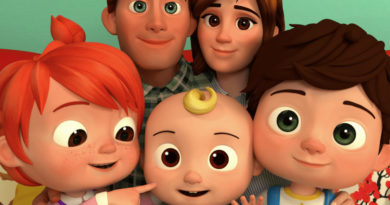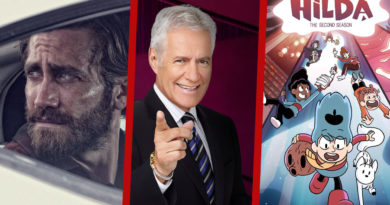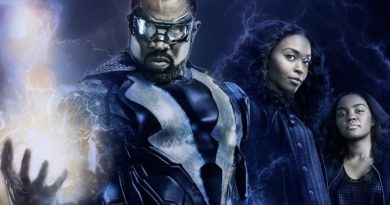Watership Down Review: Great Voice Cast, Puzzling Style
This article comes from Den of Geek UK.
This review contains spoilers.
You’d have to be made of stone to not get a little something in your eye at the close of director Noam Murro’s two-part series. It’s an emotional finale to a unique story of companionship, survival and human destruction that had readers of Richard Adams’ 1972 novel and viewers of Martin Rosen’s 1978 film wiping away tears.
For all the peril the rabbits experience after fleeing their doomed warren to find the beautiful Watership Down, we don’t expect the emotional gut-punch of Hazel’s visit from the black rabbit as he finally rests, aged and weary, in the safety of his well-earned home. We’re prepared for his death in a vicious fight to the death with Captain Woundwort, but we’re never quite ready for the far more moving ending as the leader of the rabbits is gently guided to the Owsla in the sky having grown old among those he loves.
The black rabbit is particularly beautiful in this version of the story; less an obscure, expressionistic shadow as depicted in the 1978 film and more of a tangible creature with the qualities of a guardian angel and the gentle, comforting voice of Rosamund Pike. For all the terror the story will instil in a new generation of youngsters this Christmas, it projects a very positive picture of death: that it’s nothing to be feared and that, when the time’s right, you’ll be led gently by the hand to a place of peace. Shut up, you’re crying.
read more: Complete Schedule of Christmas Movies and TV Shows
The series does take some time to get to this resolution, however. The first instalment entertainingly introduces the gang of rabbits, Fiver’s alarming visions and their hazardous quest to find a new home with the enraged Captain Holly in hot pursuit. It’s gripping and wonderfully haunting in places, especially as the rabbits discover Cowslip’s uncannily empty warren on their journey to safety. The second instalment, however, will likely lose some viewers. Some out of boredom, some out of confusion (rabbits look quite similar to one another, it turns out) and some because they’re 10 years old and simply don’t have the attention span for an hour and 40 minutes-worth of Efrafa-based politics.
Of course, the horrible rabbit slave camp that is Efrafa is a big feature of the original story, but it’s a curious decision on the part of the remake’s director to dedicate a full feature-length half to the comings and goings of new characters and spies in this most morbid of rabbit hellholes. It’s likely that young viewers will get the most out of the moments when the small gang are together and, frankly, more distinguishable from the sea of evil and sort-of-evil rabbits that are endlessly threatening them with death. “It’s time to finish this warren once and for all!”, shouts an Efrafaian over an hour into the relentless rabbit warfare. I must be excused for thinking, only briefly, that I wish they would get on and do it.
Wanting to spend less time in Efrafa is not to say the show needed to dial back its dark and melancholic tone, however. To the contrary, it amps up the darkness to great effect (see my piece on the traumatising features of the new Watership Down). Fiver’s visions are alarmingly presented, with horrifying echoes of trench warfare as we witness rabbits crammed into their warrens and killed at the hands of man in the name of progress, while the CGI makes injuries suffered by the rabbits all the more visceral.
Let’s talk about the CGI, though, because while it makes the rabbits more realistic in comparison to the 1978 film, there’s definitely something amiss with how the creatures are rendered in this age of astonishing graphics. The rabbits move… strangely. It’s difficult to pinpoint exactly what is wrong with how they hop and run while you’re trying to ascertain which character is which, but something doesn’t sit quite right. They move jerkily and with seemingly little to no weight behind them as they seem to ping off the ground like Cube Hopper (remember him?).
There are moments when the rabbits’ unusual movement isn’t as much of an issue, largely down to some great voice performances, but there is a lot of motion blur as they run, leaving it difficult to focus on chase sequences until the characters slow or stop. At the start of the second half, Clover is seen weightlessly bounding through fog in search of Hazel. Our view of her jolts wildly left and right and it looks for all the world like a dodgy first-person shooter game. Probably not the impression the creative team were going for in a show that overtly denounces the destructive nature of humankind.
Daniel Kaluuya, Mackenzie Crook and Olivia Colman put in particularly notable voice performances as excitable storyteller Bluebell, lovestruck Hawkbit and the overly friendly Strawberry with a belter of a Somerset accent. Peter Capaldi, too, is great as the grumpy gul Kehaar whose nonsensical squawks in the 1978 film have mercifully been replaced by the voice of a sassy Scotsman.
It does feel as though the show’s humour is reined in as much as possible to maintain the dark tone, however. Just as you’ll be willing the final battle to be over, you’ll be willing the show to give in to its more light-hearted moments and achieve its comic potential, if only because – as we all know – comedy and tragedy make a fantastic dramatic pairing. While it might not look perfect and it is much too long, it’s a must-see for fans of the story. The key events and wholesome message of the novel remain and the closing shot is simply stunning.


